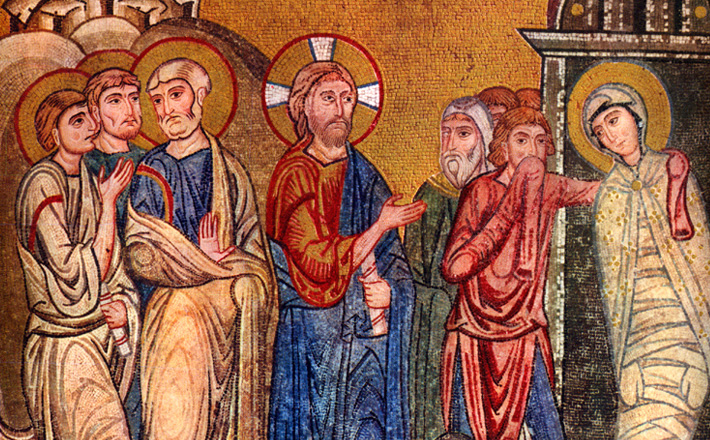Commentary on Romans 8:6-11
School children are often asked to name their heroes.
This type of task gives them a chance to think about the qualities that make a role model and how they might imitate someone they admire. When my boys were young, they would don a chestnut hooded cape, grab a light saber and cry “may the Force be with you” and set out to destroy evil as they saw it. As they have grown through the years, their heroes have changed from superheroes to sports personalities to historical figures to people they know. When they admire someone, they tend to dress like them, talk like them, and act like them. They appear to take on their form.
Romans 8:6-11 fits into a larger discussion about the way believers take on the form of Christ. In these verses, Paul builds on his description of the believer’s life in Christ, for which he has laid the foundation in Romans 6. There, Paul exposes the incongruity of sin in the life of the believer (6:1-4), and then develops a series of contrasts to explain the radical new life in Christ: it is characterized by the movement from one state of being to another (death to life), from one master to another (sin to God), from one principle to another (law to grace), and one kind of activity to another (wickedness to righteousness). Robert Tanehill comments, “Christ’s death and resurrection are continuing aspects of the ‘form’ of Christ … so that believers take on the same ‘form.’”1 That is, believers become like Christ; they are transformed into his image by dying and rising with him.
In Romans 8, Paul develops this line of thought by characterizing the contrasts of Romans 6 as “flesh” versus “Spirit.” This is an antithesis between the old age ruled by sin that results in unrighteousness and death; and the new eschatological age ruled by the Spirit that results in righteousness and life. Reading Romans. 6 and 8 together, we might say that Paul presents unbelievers as belonging to the realm of the flesh where sin reigns and enslaves people to unrighteousness, resulting in death; and believers as belonging to the realm of the Spirit where God enslaves people to righteousness, resulting in life.
Throughout Rom 8:6-11, Paul juxtaposes life in the realm of the flesh and life in the realm of the Spirit by repeating the language of the mind: Those who live in conformity with the flesh think things that are of the flesh, while those who live in conformity with the Spirit think things that are of the Spirit. In other words, the age or realm to which people belong aligns with their thinking and generates their behavior. For Paul, the power of sin is not only personal, but also cosmic. The sin-sick cycle that determines the thinking and actions of individuals, of groups, of the world is complex and requires divine help.
For this reason, the Spirit does not merely characterize a realm or an age; the Spirit also works in believers and communities. Paul explains the presence and work of the Spirit in two important ways. First, while he had earlier argued that believers’ living is based on being “in Christ Jesus” (6:11), he now states that it is based on “Christ in you” which he defines as “the Spirit of God in you” (8:9-12). Second, while Paul had earlier stated that sin used to dwell in those apart from Christ (7:17, 20, 23), he now states that the Holy Spirit dwells in the believer (8:9, 11), creating new life. God does what the law was unable to do, first through Christ’s atoning death (8:3) and now, on that basis, through the transforming work of the Spirit (8:4-11).
Based on 8:6-11, Paul tells believers that if they put to death the practices of the body by the Spirit they will live (verses. 12-13; see also 6:11). The Spirit’s work is to replicate the life of Christ in believers both at the present time through obedience in righteousness (1:18; 6:13, 16, 18, 20) — “the Spirit is life because of righteousness” — and in the future through resurrection — “he who raised Christ … will give life to your mortal bodies through his Spirit” (8:11). The Holy Spirit continues the work of producing the form of Christ in believers. That is, believers take on the form, or image, of Christ by dying and rising with him (Romans 6) and by living in conformity with the Spirit (Romans 8).
Romans 8:6-11 is thus an important part of Paul’s developing argument that believers are taking on the form of Christ. Believers are obligated to live now according to the Spirit (8:12) because this Spirit has a future claim on them: Just as God appointed (horizo) Jesus to be Son of God with power by the Spirit through the resurrection from the dead (see also 1:3-4), God has pre-appointed (proorizo) that believers will be conformed to the image of his Son by this same Spirit (8:29).
In the meantime, this Spirit bears witness that believers are children of God and co-heirs with Christ of God’s glory (8:14-18). And the Spirit performs the process of transformation into the image of Christ individually and corporately as the members of Christ’s body discern righteous thinking that is manifest in righteous conduct that pleases God (12:1-5). Such conduct is marked by self-sacrificial love and enables a diverse community to glorify God together (Romans. 12-15, especially 13:8-10; 15:1-6).
To be in Christ is to take Christ’s form, dying and rising with him and living in conformity with the Spirit. Taking the form of Jesus is not optional for Christians, but is the very essence of who we are as individuals and a community, both now and in the future.
Notes:
1 Robert C. Tanehill, Dying and Rising with Christ: A Study in Pauline Theology (Eugene, OR: Wipf and Stock, 2006), 38-39.


April 2, 2017